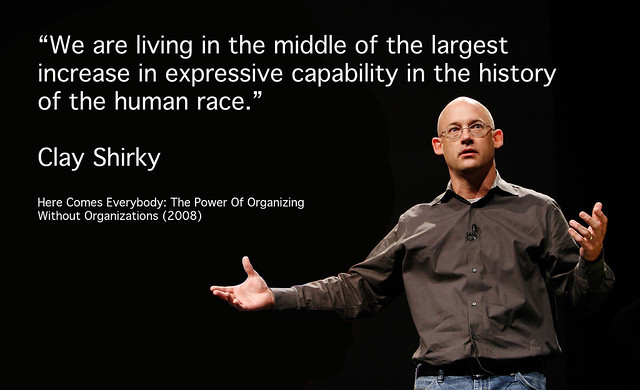
This post is part of a serialized collection of chapters composing my recently completed Master’s of Education degree at the University of Victoria. You can access the other chapters on this site here, and access a pdf of the completed paper on the University of Victoria library space here.
As Clay Shirky noted now almost ten years ago, “We are living in the middle of the largest increase in expressive capacity in the history of the human race” (2008, p. 106), prompting many educational stakeholders to encounter a digital age in which “forms of information have changed drastically” (Simsek & Simsek, 2013, p. 127), inducing what may be viewed as a state of shock. They explain:
Information is an integral part of daily life in today’s society in order for individuals to survive against information-related requirements. Production of knowledge requires different skills than those necessary for producing goods. Thus, the concept of shock could be interpreted partly as the feelings of the confusions of people, being aware of not having necessary skills for the new literacies. (p. 127)
While pervasive across the affected culture, this type of societal confusion represents an opportunity to reform collective enterprises including, but certainly not limited to, monetary policy and public schooling. Naomi Klein notes in The Shock Doctrine (2008) that such ‘shocks’ are opportunities for radical interventions in policy reform, citing the champion of neoliberal capitalism Milton Friedman’s admission that “Only a crisis – actual or perceived – produces real change. When that crisis occurs, the actions that are taken depend on the ideas that are lying around” (p. 166). This holds true as schools look to encounter the shock of producing a curriculum for the digital age, as David Berry highlights “the plasticity of digital forms and the way in which they point toward a new way of working with representation and mediation […] whereby one is able to approach culture in a radically new way” (2011, p. 1).
Educationists and those who would ensure that the educational “ideas that are lying around” in the midst of such a shock ought consider critically the role that curriculum plays in adequately equipping young people to inherit and recreate a society that reflects Canadian pluralist ideals: a skillset and disposition we might broadly encapsulate as “citizenship.” This project outlines a particular conception of citizenship curriculum for the digital age that it might be an “idea lying around” as stakeholders look to reform education in the 21st century. The citizenship proposed here intends to address inequalities inherent in democratic systems by helping bring about the “full and active participation of each member of society” promised by the Multicultural Act of Canada (Canadian Multiculturalism Act, c 24 (4th Supp), 1985), as well as the representation of all members of Canadian society in the ongoing construction of the national identity.
Integral to this conception of citizenship learning is the notion that
“Young people learn at least as much about democracy and citizenship – including their own citizenship – through their participation in a range of different practices that make up their lives, as they learn from that which is officially prescribed and formally taught” (Biesta, Lawy, & Kelly, 2009, p. 3).
In looking to design educational opportunities in which young people can experience authentic citizenship learning, curriculum cannot be bound to a static perception of content, skills, or outcomes, but rather must emerge from an exploration of the lives of young people (see: Freire, Osberg, Biesta). As a result, the project considers forces impacting the democratic realities of youth, and looks to allow for the creation of a new narrative of citizenship learning to emerge in the process of the unit framework outlined here.
Featured image courtesy of Alan Levine.